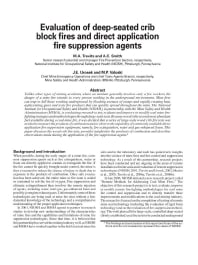Mining Publication: Evaluation of Deep-Seated Crib Block Fires and Direct-Application Fire Suppression Agents
Original creation date: December 2007
Authors: MA Trevits, AC Smith, JE Urosek, MP Valoski
NIOSHTIC2 Number: 20033109
Trans Soc Min Metall Explor 2007 Dec; 322:92-102
Unlike other types of mining accidents, where an incident generally involves only a few workers, the danger of a mine fire extends to every person working in the underground environment. Mine fires can trap or kill those working underground by blocking avenues of escape and rapidly creating heat, asphyxiating gases and toxic fire products that can quickly spread throughout the mine. The National Institute for Occupational Safety and Health (NIOSH), in partnership with the Mine Safety and Health Administration (MSHA), is conducting research to test, evaluate and improve or modify coal mine fire-fighting strategies and methodologies through large-scale tests. Because wood is the second most abundant fuel available during a coal mine fire, it was decided that a series of large-scale wood crib fire tests was needed to measure the products of combustion and to observe the capability of commonly available direct application fire suppression equipment, namely, fire extinguishers, water and gas-enhanced foam. This paper discusses the wood crib fire tests, provides insight into the products of combustion and describes observations made during the application of the fire suppression agents.

NIOSHTIC2 Number: 20033109
Trans Soc Min Metall Explor 2007 Dec; 322:92-102
- Analysis of Mine Fires for All U.S. Metal/Nonmetal Mining Categories, 1990-2001
- Effectiveness of Various Concentrations of an Inert Gas Mixture for Preventing and Suppressing Mining Equipment Cab Fires: Development of a Dual-Cab Fire Inerting System
- Evaluation of the Bagged Stone Dust Barrier Effectiveness in a Bord and Pillar Mine
- Inflatable Partitions for High-Expansion Foam Generators
- Innovative Strategies for Mine Fire Preparedness
- Mine Fires - Measuring the Efficacy of Gas-Enhanced Foam
- Performance-Based Fire Safety Designs for Self-Escape in Underground Mines
- Remote Mine Fire Suppression Technology
- The Status of Mine Fire Research in the United States
- Understanding Mine Fire Disasters by Determining the Characteristics of Deep-Seated Fires